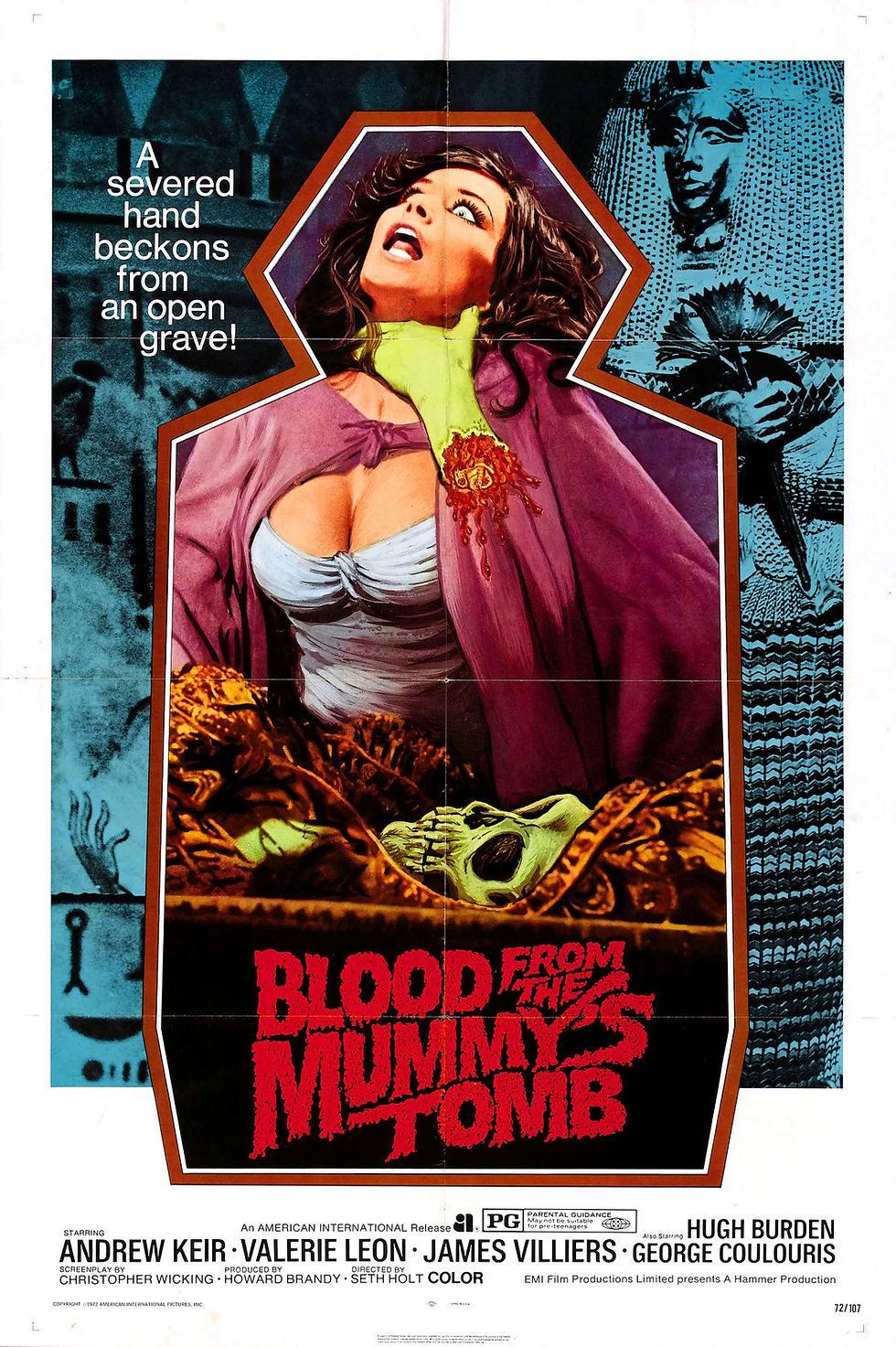Mummy Week, Day 5: Blood from the Mummy's Tomb (1971)
- Classic Horrors Club

- Jun 8, 2017
- 4 min read
Updated: Aug 1, 2020


Hammer's cycle of mummy movies provides evidence of the evolution of the studio, as well as film making styles in general. The Mummy (1959) represents the classic Hammer Horror style, simple stories told on big, lavish sets. The Curse of the Mummy's Tomb (1964) represents a transition in style. It adds looser storytelling with more modern, adult sensibilities to the familiar physical elements of the classic era. The Mummy's Shroud (1967) represents more complex storytelling and favors location shooting with fluid camera movements that bear little resemblance to the classic style.
.
Blood from the Mummy's Tomb (1971) fully embraces its decade. Blood that was once completely missing, then made occasional surface appearances, is now literally flowing. Clothing that once covered bare skin, then became skimpier, is now entirely absent. Many people consider this evolution of sex and gore to be the devolution of Hammer Films. More often than not, though, I find myself enjoying their later films. This one in particular pays deliberate attention to atmosphere and mood, with style over substance. The threat is not even a physical mummy; it's the abstract idea of reincarnation of an astral being.
.
In one sequence, two orderlies walk down the hall of a mental institution as the "dawn chorus" of voices belonging to unseen patients behind locked doors start laughing, moaning and screaming. Slowly, the camera tilts and pans back down the hall, lingering at each door using a variety of unusual angles. It then enters the room of Professor Berrigan (George Coulouris), dressed in a straitjacket, tossing and turning on his bed.
.
Suddenly he becomes still and all noise is silenced. The camera lingers on his face for a long, quiet moment…
…then, the windows blow open and invisible forces violently destroy the room. As the camera continues to move around the room, we hear the death of Berrigan, but do not see it. Panning across the floor, we then hear a dripping noise. It's water falling from an overturned vase. As the camera moves further, the drops turn red. It rises to reveal a gaping wound on Berrigan's neck, pulsing slightly as it bleeds. You didn't see a scene like this, with either the gore or the style, in 1959, 1964 or 1967.
.
Director Seth Holt died on the set of Blood from the Mummy's Tomb, leaving Michael Carreras to complete the movie with five days of shooting. I've previously bad-mouthed Carreras; however, he supposedly directed this fantastic sequence in the institution. It's similar to a scene Holt probably directed, where the camera moves around a foggy alley, the sound describes the action, and shadows dance on the brick walls. We may only see part of Geoffrey Dandridge's (Hugh Burden) dead body, but the horrified look on Tod Browning's (Mark Edwards) face provides any missing visual details.
.
These murders are a result of collecting the ancient relics required to resurrect Queen Tera within the physical body of Margaret Fuchs (Valerie Leon). Her father, Professor Julian Fuchs (Andrew Keir) and his team had discovered the perfectly preserved queen in a sarcophagus during an expedition. She's beautiful, but is missing her right hand. At the same time, in another place, Professor Fuchs's wife gives birth to Margaret and dies. Doctors think the baby is dead, too, but its heart starts beating just as Tera's stump starts bleeding.
.
This is revealed in a dream sequence as adult (and naked) Margaret sleeps restlessly. She's somehow channeling Tera and there's talk that they may actually be the same person. Likewise, prior to this, she dreamed about a time further back when Tera was imprisoned in the sarcophagus, her hand removed and fed to the jackals in hopes that an incomplete body would somehow contain her evil. A giant ruby ring was taken from the hand and Professor Fuchs gives it to Margaret as an early birthday present.
.
The details are a little fuzzy about who wants exactly what to happen. Professor Fuchs probably wants to save his daughter, so why did he give her the ring? It's clear that Corbeck (James Villiers), one of his colleagues, is the bad guy, though. He wants complete control over life and death and claims Fuchs is weak. "The meek shall not inherit the earth!" He convinces Margaret to join him, probably because she's under the influence of Tera as her spirit gains strength. Again, I'm not sure if the ultimate goal is to save Margaret or destroy Tera; they aren't necessarily the same thing.
.
Blood from the Mummy's Tomb is based on the Bram Stoker novel, The Jewel of the Seven Stars, but I don't know how faithfully. The movie contains recurring images of seven blue lights, whether they are in the night sky, in the murky depths of the ring, or in the crystal ball of Helen Dickerson (Rosalie Crutchley), another colleague that's in possession of a relic and meets an untimely fate. After all the relics are collected, the body count continues to rise as those who threaten to interfere with Corbeck's plans are eliminated.
.
Although the final shot evokes previous mummy movies (and provides a clever, ambiguous twist), this is more a movie about an unseen supernatural menace than it is about a physical, bandage-wrapped monster. At times, when windows blow open and wind whips through an interior, it reminds me of a ghost or haunted house movie. There's even a thunderstorm at one point, using a Gothic element that other mummy movies don't. It's unusual and, 12 years after Hammer's original The Mummy, has evolved into a different type of movie entirely. I really like it.







Comments